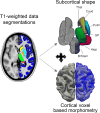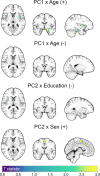This is a preprint.
The subcortical correlates of self-reported sleep quality
- PMID: 38854024
- PMCID: PMC11160773
- DOI: 10.1101/2024.05.29.596530
The subcortical correlates of self-reported sleep quality
Update in
-
The subcortical correlates of self-reported sleep quality.Sleep. 2025 May 4:zsaf115. doi: 10.1093/sleep/zsaf115. Online ahead of print. Sleep. 2025. PMID: 40341392
Abstract
Study objectives: To assess the association between self-reported measures of sleep quality and cortical and subcortical local morphometry.
Methods: Sleep quality, operationalized with the Pittsburgh Sleep Quality Index (PSQI), and neuroanatomical data from the full release of the young adult Human Connectome Project dataset were analyzed (N=1,112; 46% female; mean age: 28.8 years old). Local cortical and subcortical morphometry was measured with subject-specific segmentations resulting in voxelwise gray matter difference (i.e., voxel based morephometry) measurements for cortex and local shape measurements for subcortical regions. Associations between the total score of PSQI, two statistical groupings of its subcomponents (obtained with a principal component analysis), and their interaction with demographic (i.e., sex, age, handedness, years of education) and biometric (i.e., BMI) variables were assessed using a general linear model and a nonparametric permutation approach.
Results: Sleep quality-related variance was significantly associated with subcortical morphometry, particularly in the bilateral caudate, putamen, and left pallidum, where smaller shape measures correlated with worse sleep quality. Notably, these associations were independent of demographic and biometric factors. In contrast, cortical morphometry, along with additional subcortical sites, showed no direct associations with sleep quality but demonstrated interactions with demographic and biometric variables.
Conclusions: This study reveals a specific link between self-reported sleep quality and subcortical morphometry, particularly within the striatum and pallidum, reinforcing the role of these regions in sleep regulation. These findings underscore the importance of considering subcortical morphology in sleep research and highlight potential neuromodulatory targets for sleep-related interventions.
Keywords: Caudate; Neuroanatomy; Neuroimaging; Pallidum; Putamen; Sleep and Brain.
Conflict of interest statement
Disclosures No competing interest is declared.
Figures





Similar articles
-
The subcortical correlates of self-reported sleep quality.Sleep. 2025 May 4:zsaf115. doi: 10.1093/sleep/zsaf115. Online ahead of print. Sleep. 2025. PMID: 40341392
-
Specific cortical and subcortical grey matter regions are associated with insomnia severity.PLoS One. 2021 May 26;16(5):e0252076. doi: 10.1371/journal.pone.0252076. eCollection 2021. PLoS One. 2021. PMID: 34038462 Free PMC article.
-
Abnormal Gray Matter Shape, Thickness, and Volume in the Motor Cortico-Subcortical Loop in Idiopathic Rapid Eye Movement Sleep Behavior Disorder: Association with Clinical and Motor Features.Cereb Cortex. 2018 Feb 1;28(2):658-671. doi: 10.1093/cercor/bhx137. Cereb Cortex. 2018. PMID: 28591814
-
Cortical and Subcortical Gray Matter Volume in Youths With Conduct Problems: A Meta-analysis.JAMA Psychiatry. 2016 Jan;73(1):64-72. doi: 10.1001/jamapsychiatry.2015.2423. JAMA Psychiatry. 2016. PMID: 26650724 Review.
-
Neuroanatomical differences in obesity: meta-analytic findings and their validation in an independent dataset.Int J Obes (Lond). 2019 May;43(5):943-951. doi: 10.1038/s41366-018-0164-4. Epub 2018 Jul 18. Int J Obes (Lond). 2019. PMID: 30022057 Review.
References
Publication types
Grants and funding
LinkOut - more resources
Full Text Sources
